Tanuf Star
Party & other Astro Ramblings
(A non too logical mix of
astro images I made in 2000)
I joined the Ras al Hamra Club
astro section on its star party to Jebel Tanuf on the night of 28/29th September
2000. Our fearless leader (who shall remain nameless!) led us to join the track
zig-zagging up the jebel below, behind the red and white sign. And we promptly
got lost! OK, he is excused. It was still daylight and he could not see the
stars to navigate by. One could see the track, though... Second attempt was
successful and we slowly wound our way up to the 2000+ meter elevation
campsite.
 It's a long, rugged drive. Photo below
taken on the way back in the morning:
It's a long, rugged drive. Photo below
taken on the way back in the morning:

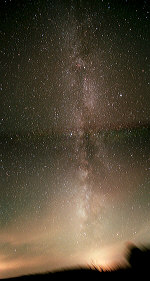 Unfortunately there was light cloud
throughout the evening, clearing up to a superb sky only after midnight. Since
most of our campers prefer a good night's rest (not exactly a bunch of
determined astronomers!) most were asleep by then. Nevertheless I managed to
take some Milky Way photos in the early evening. Two of them are shown spliced
below, each a 20 minute exposure on Fuji 800 colour negative film, 14mm/2.8
Tamron lens wide open. The camera was piggy-backed on my Celestron Ultima
2000-8" on an equatorial wedge, to track the sky. The small version above is to
hint at what's coming, in case the main photo is still downloading ever so
slowly by camel train ;-) Sorry for the long download time; the image has to be
at least this big in order to see much of anything. The two photos span all the
way from Antares in the south, just above the horizon, right up to almost
Polaris (which is just outside the top right of the photo). Even at the
diminished resolution used here for the web, it is possible to just make out the
red North America Nebula to the upper left of Deneb. See the reddish
patch?
Unfortunately there was light cloud
throughout the evening, clearing up to a superb sky only after midnight. Since
most of our campers prefer a good night's rest (not exactly a bunch of
determined astronomers!) most were asleep by then. Nevertheless I managed to
take some Milky Way photos in the early evening. Two of them are shown spliced
below, each a 20 minute exposure on Fuji 800 colour negative film, 14mm/2.8
Tamron lens wide open. The camera was piggy-backed on my Celestron Ultima
2000-8" on an equatorial wedge, to track the sky. The small version above is to
hint at what's coming, in case the main photo is still downloading ever so
slowly by camel train ;-) Sorry for the long download time; the image has to be
at least this big in order to see much of anything. The two photos span all the
way from Antares in the south, just above the horizon, right up to almost
Polaris (which is just outside the top right of the photo). Even at the
diminished resolution used here for the web, it is possible to just make out the
red North America Nebula to the upper left of Deneb. See the reddish
patch?
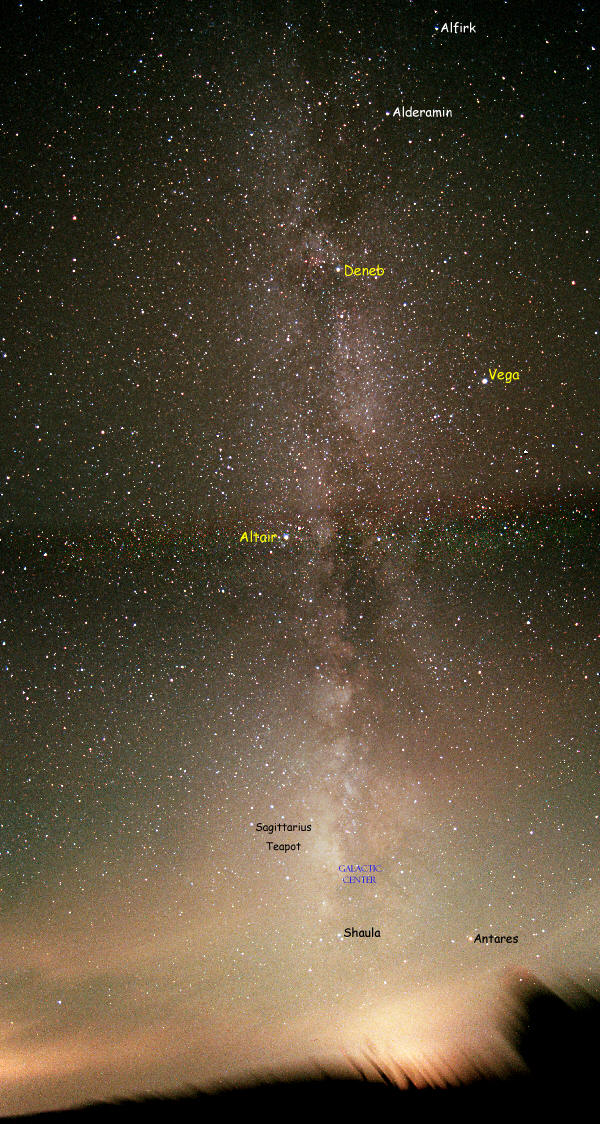 Also note the Galactic Center (of
our Milky Way galaxy) which is just off the brightest patch because of some dark
intra-galactic clouds (nebulae) getting in the way of our line-of-sight.
Actually it's rather interesting the way our Earthly clouds mingle with the star
clouds of the Milky Way. The Earthly clouds near the horizon are also lit up by
light pollution from the town of Nizwa, some 30km away. Below is a
photo of the campsite the next morning:
Also note the Galactic Center (of
our Milky Way galaxy) which is just off the brightest patch because of some dark
intra-galactic clouds (nebulae) getting in the way of our line-of-sight.
Actually it's rather interesting the way our Earthly clouds mingle with the star
clouds of the Milky Way. The Earthly clouds near the horizon are also lit up by
light pollution from the town of Nizwa, some 30km away. Below is a
photo of the campsite the next morning:
 Our galaxy, the Milky Way is believed
to be fairly similar to the Andromeda Galaxy, M31, which is about 2.3 million
light years away. M31 is part of our "Local Group" of galaxies and, if you know
exactly where to look, you can just about make out its faint hazy glow from a
dark sky site. Actually, what we make out is the glow of its central bulge/core.
Binoculars help in gathering more light and the glow is then very obvious. But
M31 subtends a large angle and the image below was taken with a STANDARD(!)
50mm/1.8 lens for a Canon EOS 35mm camera. Who says you need a telescope to take
photos of galaxies?! In this case the telescope just served as a piggy-back
mount, in a manner similar to the previous Milky Way shots. Taken from the roof
of my house at Ras al Hamra, Muscat. 60 exposures each 30 secs long were
accumulated, and even then the outer spiral arms are still too faint to show
above our local, urban light pollution. See the same-scale chart lower down
which traces a considerably larger outline for M31. This is my first attempt at
imaging anything outside our Milky Way. One can say that this astrophotography
business indeed needs a lot of patience... For Heaven's sake, how many hours
exposure is enough?!
Our galaxy, the Milky Way is believed
to be fairly similar to the Andromeda Galaxy, M31, which is about 2.3 million
light years away. M31 is part of our "Local Group" of galaxies and, if you know
exactly where to look, you can just about make out its faint hazy glow from a
dark sky site. Actually, what we make out is the glow of its central bulge/core.
Binoculars help in gathering more light and the glow is then very obvious. But
M31 subtends a large angle and the image below was taken with a STANDARD(!)
50mm/1.8 lens for a Canon EOS 35mm camera. Who says you need a telescope to take
photos of galaxies?! In this case the telescope just served as a piggy-back
mount, in a manner similar to the previous Milky Way shots. Taken from the roof
of my house at Ras al Hamra, Muscat. 60 exposures each 30 secs long were
accumulated, and even then the outer spiral arms are still too faint to show
above our local, urban light pollution. See the same-scale chart lower down
which traces a considerably larger outline for M31. This is my first attempt at
imaging anything outside our Milky Way. One can say that this astrophotography
business indeed needs a lot of patience... For Heaven's sake, how many hours
exposure is enough?!
 Sky chart of the area covered follows,
note also the smaller galaxies, M32 and M110. The red circle shows the angular
size of the Moon at the same scale. Isn't the angular size of M31 just
astounding? Never mind the fact that it contains over a billion stars! An
interesting peculiarity. Notice the red star (on the chart) just outside the
outline of M31 on the upper right? Because the CCD used is overly sensitive to
red and infrared, this star just lights up like a beacon in the photo compared
to similarly-sized blobs on other stars. The blobs on the chart are sized
relative to "visual" magnitudes, i.e. excluding infrared.
Sky chart of the area covered follows,
note also the smaller galaxies, M32 and M110. The red circle shows the angular
size of the Moon at the same scale. Isn't the angular size of M31 just
astounding? Never mind the fact that it contains over a billion stars! An
interesting peculiarity. Notice the red star (on the chart) just outside the
outline of M31 on the upper right? Because the CCD used is overly sensitive to
red and infrared, this star just lights up like a beacon in the photo compared
to similarly-sized blobs on other stars. The blobs on the chart are sized
relative to "visual" magnitudes, i.e. excluding infrared.
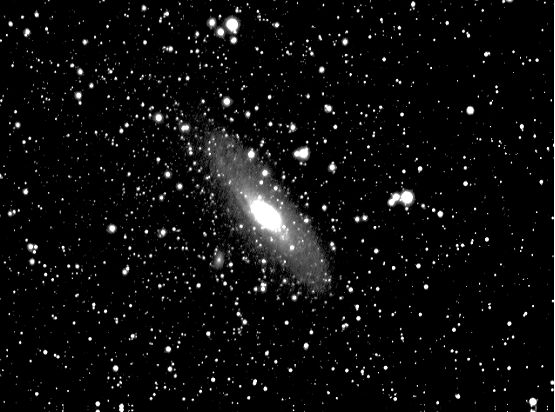 OK, if you insist on pictures through a
telescope, here is an image of Jupiter, taken with the same PixCel 237 CCD and
the Celestron Ultima 2000-8" at f20, effective focal length around 4000mm. 3 RGB
images combined:
OK, if you insist on pictures through a
telescope, here is an image of Jupiter, taken with the same PixCel 237 CCD and
the Celestron Ultima 2000-8" at f20, effective focal length around 4000mm. 3 RGB
images combined:
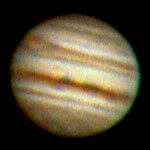 or do you prefer a monochromatic
Saturn?
or do you prefer a monochromatic
Saturn?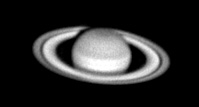
Notice the shadow of the rings on
Saturn? And the shadow of the planet on the rings? Rambling onto the
double-double star at Epsilon Lyrae, taken at f10. the pairs are separated by
208 arc-seconds and each pair is roughly 2.5 arc-secs wide. To the naked eye the
four appear like a single star.:
 The seeing was quite lousy and I had to
combine 3 monochromatic images to obtain the above result. By the way, the
theoretical diffraction limit of the telescope used is around 0.7arc-sec so, at
this magnification, things are approaching the limit.
The seeing was quite lousy and I had to
combine 3 monochromatic images to obtain the above result. By the way, the
theoretical diffraction limit of the telescope used is around 0.7arc-sec so, at
this magnification, things are approaching the limit.
For more stuff return to
Samir's Home
To drop me an e-mail just
click on:
[email protected]








 or do you prefer a monochromatic
Saturn?
or do you prefer a monochromatic
Saturn?
